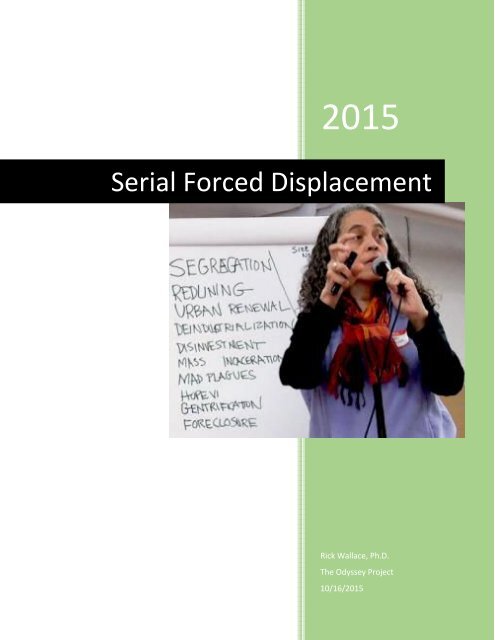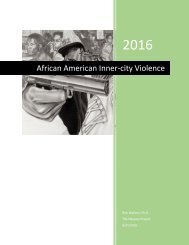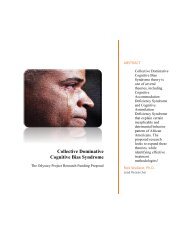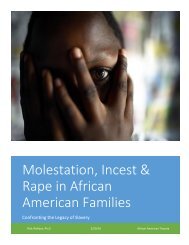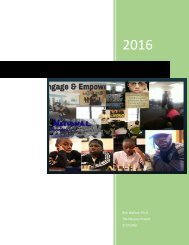Serial Forced Displacement & Its Impact on the Social Mobility and Mental Health of African Americans
Regardless to what modality that has been used, serial forced displacement is defined as the repetitive, coercive upheaval of groups (Fullilove & Wallace, 2011). When mentioned here, serial forced displacement is specifically focused on Government sanctioned methodologies and tactics that are underwritten by federal, state and local legislation that allows the wealthy to aggressively, and even hostilely encroach upon the rights and property ownership of the impoverished citizens of this country, with the vast majority of these citizens being people of color.
Regardless to what modality that has been used, serial forced displacement is defined as the repetitive, coercive upheaval of groups (Fullilove & Wallace, 2011). When mentioned here, serial forced displacement is specifically focused on Government sanctioned methodologies and tactics that are underwritten by federal, state and local legislation that allows the wealthy to aggressively, and even hostilely encroach upon the rights and property ownership of the impoverished citizens of this country, with the vast majority of these citizens being people of color.
You also want an ePaper? Increase the reach of your titles
YUMPU automatically turns print PDFs into web optimized ePapers that Google loves.
2015<br />
<str<strong>on</strong>g>Serial</str<strong>on</strong>g> <str<strong>on</strong>g>Forced</str<strong>on</strong>g> <str<strong>on</strong>g>Displacement</str<strong>on</strong>g><br />
Rick Wallace, Ph.D.<br />
The Odyssey Project<br />
10/16/2015
<str<strong>on</strong>g>Serial</str<strong>on</strong>g> <str<strong>on</strong>g>Forced</str<strong>on</strong>g> <str<strong>on</strong>g>Displacement</str<strong>on</strong>g> & <str<strong>on</strong>g>Its</str<strong>on</strong>g> <str<strong>on</strong>g>Impact</str<strong>on</strong>g> <strong>on</strong> <strong>the</strong> <strong>Social</strong><br />
<strong>Mobility</strong> <strong>and</strong> <strong>Mental</strong> <strong>Health</strong> <strong>of</strong> <strong>African</strong> <strong>Americans</strong><br />
By<br />
Dr. Rick Wallace, Ph.D.<br />
2015 Copy Right © Rick Wallace
<str<strong>on</strong>g>Serial</str<strong>on</strong>g> <str<strong>on</strong>g>Forced</str<strong>on</strong>g> <str<strong>on</strong>g>Displacement</str<strong>on</strong>g> <strong>and</strong> <strong>the</strong> Negative Repercussi<strong>on</strong>s<br />
Over <strong>the</strong> past 20 plus years I have invested a great deal <strong>of</strong> time an effort into underst<strong>and</strong>ing <strong>the</strong><br />
plight <strong>of</strong> <strong>African</strong> <strong>Americans</strong>, with <strong>the</strong> intent <strong>on</strong> devising a comprehensive strategy that can be<br />
implemented <strong>and</strong> carried out first, <strong>on</strong> a nati<strong>on</strong>al level, <strong>and</strong> <strong>the</strong>n globally. One <strong>of</strong> <strong>the</strong> issues that I<br />
identified early <strong>on</strong> is <strong>the</strong> fact that <strong>the</strong>re were some excepti<strong>on</strong>al minds that had invested a great<br />
deal <strong>of</strong> energy <strong>and</strong> effort into coming up with soluti<strong>on</strong>s to specific issues within <strong>the</strong> black<br />
collective: however, rarely were <strong>the</strong>se great minds working in unis<strong>on</strong> with <strong>on</strong>e ano<strong>the</strong>r, which is<br />
actually a reflecti<strong>on</strong> <strong>of</strong> <strong>on</strong>e <strong>of</strong> many pathologies that negatively impact <strong>the</strong> black collective.<br />
Once I discovered this dynamic <strong>of</strong> fragmented strategic data, it became my goal to study <strong>and</strong><br />
evaluate <strong>the</strong> informati<strong>on</strong>, assess <strong>the</strong> existing strategies <strong>and</strong> to develop a comprehensive program<br />
that takes all <strong>of</strong> <strong>the</strong> strategies <strong>and</strong> presents <strong>the</strong>m in a coherent manner — allowing for easy<br />
cohesive implementati<strong>on</strong>.<br />
As I currently work <strong>on</strong> The Black Community Empowerment Blueprint 1.0, <strong>and</strong> o<strong>the</strong>r active<br />
projects, I am <strong>of</strong>ten compelled to share specific details c<strong>on</strong>cerning a certain issue that is <strong>of</strong><br />
immense relevance in <strong>the</strong> attempts <strong>of</strong> blacks to rise up <strong>and</strong> become an aut<strong>on</strong>omous nati<strong>on</strong> within<br />
a nati<strong>on</strong>.<br />
Today, I would like to share some <strong>of</strong> my c<strong>on</strong>cerns as <strong>the</strong>y relate to what is known in political<br />
science <strong>and</strong> social science as serial, forced displacement — an act that has been accomplished<br />
through a number <strong>of</strong> distinct modalities over <strong>the</strong> last 100 years.<br />
Regardless to what modality that has been used, serial forced displacement is defined as <strong>the</strong><br />
repetitive, coercive upheaval <strong>of</strong> groups (Fullilove & Wallace, 2011). When menti<strong>on</strong>ed here,<br />
serial forced displacement is specifically focused <strong>on</strong> Government sancti<strong>on</strong>ed methodologies <strong>and</strong><br />
tactics that are underwritten by federal, state <strong>and</strong> local legislati<strong>on</strong> that allows <strong>the</strong> wealthy to<br />
aggressively, <strong>and</strong> even hostilely encroach up<strong>on</strong> <strong>the</strong> rights <strong>and</strong> property ownership <strong>of</strong> <strong>the</strong><br />
impoverished citizens <strong>of</strong> this country, with <strong>the</strong> vast majority <strong>of</strong> <strong>the</strong>se citizens being people <strong>of</strong><br />
color.<br />
What I am proposing here, based <strong>on</strong> a prep<strong>on</strong>derance <strong>of</strong> <strong>the</strong> evidence that is currently available,<br />
is that serial forced displacement creates a complex dynamic that produces interpers<strong>on</strong>al <strong>and</strong><br />
structural violence within <strong>the</strong> social structure <strong>of</strong> those who are being displaced. The empirical<br />
evidence that is available to support this is statistically significant, meaning that it is so great that<br />
it cannot be c<strong>on</strong>sidered coincidence. Additi<strong>on</strong>ally, serial forced displacement also results in an<br />
inability <strong>of</strong> <strong>the</strong> affected group to efficaciously resp<strong>on</strong>d or react in a timely manner to ei<strong>the</strong>r,<br />
threat or opportunity — facilitating a cyclical fragmentati<strong>on</strong> as a result <strong>the</strong> first two issues.<br />
What must be understood here is <strong>the</strong> primary motive behind serial forced displacement. While it<br />
might be c<strong>on</strong>venient to postulate that this is solely about <strong>the</strong> opportunity to pr<strong>of</strong>it from <strong>the</strong><br />
weaknesses <strong>and</strong> ignorance <strong>of</strong> <strong>the</strong> less fortunate — something that cannot <strong>and</strong> should not be<br />
dismissed, it is necessary to c<strong>on</strong>sider a more nefarious idea — planned shrinkage & benign<br />
neglect as a form <strong>of</strong> populati<strong>on</strong> c<strong>on</strong>trol. Planned shrinkage is a c<strong>on</strong>troversial policy in which <strong>the</strong>
government looks to shrink <strong>and</strong> manage <strong>the</strong> size <strong>of</strong> large cities based <strong>on</strong> <strong>the</strong> premise <strong>of</strong> a<br />
hypo<strong>the</strong>sis by Daniel Patrick Moynihan, a man who <strong>on</strong>ce champi<strong>on</strong>ed underwriting <strong>the</strong> black<br />
ec<strong>on</strong>omy by creating jobs specifically for black men, in lieu <strong>of</strong> social programs, such as welfare,<br />
food stamps <strong>and</strong> Medicaid (Wallace, 2011). Moynihan had developed an ideology that suggested<br />
that larger cities were <strong>the</strong> cause <strong>of</strong> <strong>the</strong> development <strong>of</strong> certain social pathologies, <strong>and</strong> reducing<br />
<strong>the</strong> size <strong>of</strong> cities would reduce <strong>the</strong> occurrence <strong>of</strong> <strong>the</strong>se perceived pathologies. Ano<strong>the</strong>r part <strong>of</strong> this<br />
process was known as benign neglect, which is when a city services are purposely withdrawn<br />
from certain neighborhoods that are c<strong>on</strong>sidered to be blighted.<br />
One way that benign neglect was carried out was by using block grants to shift financial<br />
resources from <strong>the</strong> inner city to <strong>the</strong> suburbs — subsequently dismantling existing Model Cities<br />
programs, as well as violating <strong>the</strong> civil rights act <strong>and</strong> <strong>the</strong> civil liberties <strong>of</strong> organizati<strong>on</strong>s <strong>and</strong><br />
individuals.<br />
When examining <strong>the</strong> history <strong>of</strong> serial forced displacement, <strong>and</strong> its relentless aggressi<strong>on</strong> towards<br />
<strong>African</strong> <strong>Americans</strong>, displacing <strong>and</strong> diluting poor <strong>African</strong> <strong>Americans</strong>, it becomes apparent that it<br />
is necessary to investigate, in great depth, <strong>the</strong> manner in which this malevolent practice has<br />
impacted <strong>the</strong> physical health, mental health <strong>and</strong> social mobility <strong>of</strong> <strong>African</strong> <strong>Americans</strong> since this<br />
practice started decades ago.<br />
The term serial refers to a series <strong>of</strong> ei<strong>the</strong>r policies <strong>and</strong>/or occurrences, <strong>and</strong> in this particular<br />
instance, serial forced displacement refers to a series <strong>of</strong> policies <strong>and</strong> <strong>the</strong> perpetuati<strong>on</strong> <strong>of</strong> a series<br />
<strong>of</strong> occurrences in which blacks have been displaced through some form <strong>of</strong> coerci<strong>on</strong>. Some <strong>of</strong> <strong>the</strong><br />
policies that had a direct impact <strong>on</strong> <strong>the</strong> displacement <strong>of</strong> black families in <strong>the</strong> inner city include<br />
redlining, urban renewal, gentrificati<strong>on</strong>, segregati<strong>on</strong>, planned shrinkage, mass criminalizati<strong>on</strong>,<br />
deindustrializati<strong>on</strong> (Something that completely decimated <strong>the</strong> inner city neighborhoods in<br />
Detroit, MI), catastrophic disinvestment <strong>and</strong> more (Fullilove & Wallace, 2011).<br />
O<strong>the</strong>r processes that have worked against blacks in this strategic move to displace <strong>and</strong><br />
disorganize <strong>the</strong> black populace include <strong>the</strong> crack epidemic <strong>of</strong> <strong>the</strong> 1980s, <strong>and</strong> <strong>the</strong> overcriminalizati<strong>on</strong><br />
<strong>of</strong> behaviors that are c<strong>on</strong>sidered to be highly appropriated into <strong>the</strong> black culture.<br />
We have actually seen disaster be used as a method <strong>of</strong> forced displacement, with <strong>the</strong> most<br />
prevalent example <strong>of</strong> this being New Orleans <strong>and</strong> <strong>the</strong> government’s h<strong>and</strong>ling <strong>of</strong> <strong>the</strong> Hurricane<br />
Katrina catastrophe, which displaced hundreds <strong>of</strong> thous<strong>and</strong>s <strong>of</strong> blacks. While <strong>the</strong> city is<br />
rebuilding <strong>and</strong> its ec<strong>on</strong>omy has definitely rebounded, blacks were not included in <strong>the</strong> rebuilding<br />
equati<strong>on</strong>. A city that has always had a dominant <strong>African</strong> American representati<strong>on</strong>, no l<strong>on</strong>ger<br />
does.<br />
While I use Redlining, Urban Renewal <strong>and</strong> Gentrificati<strong>on</strong> syn<strong>on</strong>ymously in most <strong>of</strong> my prose, it<br />
is necessary to illuminate <strong>the</strong> fact that while <strong>the</strong>se different mechanisms accomplished <strong>the</strong> same<br />
goal, <strong>the</strong> instruments that make <strong>the</strong>m possible are distinctly different — representing different<br />
eras. Basically, when <strong>on</strong>e form <strong>of</strong> forced displacement would be outlawed through c<strong>on</strong>stituti<strong>on</strong>al<br />
amendment or statutory evoluti<strong>on</strong>, ano<strong>the</strong>r method would be created to replace it.<br />
Redlining was a mechanism that was instituted by <strong>the</strong> U.S. government, through <strong>the</strong> Home<br />
Owners Loan Corporati<strong>on</strong> in 1937. This was an act that was intended to discourage lending in
what was c<strong>on</strong>sidered risky neighborhoods, resulting in people from certain neighborhoods being<br />
denied financing. These neighborhoods that were classified as risky were those with older<br />
buildings <strong>and</strong> black residents. To fur<strong>the</strong>r elucidate <strong>the</strong> pernicious intent <strong>of</strong> this particular policy,<br />
<strong>the</strong> existence <strong>of</strong> even <strong>on</strong>e black home owner in a particular community would result in <strong>the</strong> worst<br />
possible rating, which also created a hostile envir<strong>on</strong>ment in which whites would fight to keep<br />
blacks out <strong>of</strong> <strong>the</strong>ir community.<br />
Urban renewal was ano<strong>the</strong>r modality through which <strong>the</strong> government was able so successfully<br />
displace milli<strong>on</strong>s <strong>of</strong> <strong>African</strong> <strong>Americans</strong>. This policy was instituted by <strong>the</strong> federal Housing Act <strong>of</strong><br />
1949 — providing for <strong>the</strong> seizure <strong>of</strong> property, through <strong>the</strong> power <strong>of</strong> eminent domain, in areas<br />
that were deemed blighted. Once <strong>the</strong> property was seized, it was cleared <strong>of</strong> all structures <strong>and</strong><br />
property <strong>and</strong> sold at a discounted price.<br />
Gentrificati<strong>on</strong> is a subtler form <strong>of</strong> serial forced displacement in which investors buy up property<br />
in poor inner city neighborhoods for pennies <strong>on</strong> <strong>the</strong> dollar, <strong>and</strong> <strong>the</strong>n <strong>the</strong>y build properties <strong>and</strong><br />
businesses that drive up property values — placing poor families in a positi<strong>on</strong> in which <strong>the</strong>y can<br />
no l<strong>on</strong>ger afford <strong>the</strong> property taxes <strong>on</strong> <strong>the</strong>ir homes. In many instances, poor black families have<br />
lost homes that <strong>the</strong>y have owned for decades.<br />
Gentrificati<strong>on</strong> is <strong>the</strong> practice <strong>of</strong> replacing lower income families with more ec<strong>on</strong>omically affluent<br />
residents, <strong>the</strong> rapidity <strong>and</strong> relentlessness <strong>of</strong> this particular practice have increased exp<strong>on</strong>entially<br />
over <strong>the</strong> last 15 to 20 years. While <strong>the</strong> dominant society views gentrificati<strong>on</strong> as a normal <strong>and</strong><br />
organic occurrence, it is anything but. The more affluent, predominantly white residents that<br />
push out <strong>the</strong> impoverished, predominantly black residents are not simply acquiring vacant<br />
property, <strong>the</strong>y are forcibly creating those vacancies — revealing this practice for what it is<br />
au<strong>the</strong>ntically — hostile <strong>and</strong> forced displacement.<br />
In additi<strong>on</strong> to <strong>the</strong> c<strong>on</strong>sequence <strong>of</strong> creating a de facto internal refugee populati<strong>on</strong>, serial forced<br />
displacement also creates a number <strong>of</strong> significant health <strong>and</strong> behavioral characteristics that are<br />
inextricably c<strong>on</strong>nected to this dynamic, including interpers<strong>on</strong>al <strong>and</strong> structural violence, substance<br />
abuse, family disintegrati<strong>on</strong>, sexually transmitted diseases <strong>and</strong> more (DeGruy, 2009) (Rothstein,<br />
2014). To help us underst<strong>and</strong> <strong>the</strong> dynamics <strong>and</strong> effects <strong>of</strong> social disintegrati<strong>on</strong> Alex<strong>and</strong>er<br />
Leight<strong>on</strong> created what is known as <strong>the</strong> stage-state model <strong>of</strong> social disintegrati<strong>on</strong>, which was<br />
designed to effectively articulate what happens to communities that are negatively affected by a<br />
series <strong>of</strong> policies designed to forcibly displace <strong>the</strong>m (Leight<strong>on</strong>, 1959).<br />
Leight<strong>on</strong> presented two distinct polarities that were identified as integrati<strong>on</strong> <strong>and</strong> disintegrati<strong>on</strong>,<br />
with integrati<strong>on</strong> existing as an internal interc<strong>on</strong>necti<strong>on</strong> that was underwritten by mutual support.<br />
C<strong>on</strong>versely, disintegrati<strong>on</strong> was characterized by an individualistic paradigm that encouraged<br />
individualism <strong>and</strong> disunity. The stage-state model presented a hypo<strong>the</strong>sis that proposed that<br />
disintegrati<strong>on</strong> was <strong>the</strong> result <strong>of</strong> a natural progressi<strong>on</strong> in which individualism resulted in a series<br />
<strong>of</strong> negative events that would ultimately lead to <strong>the</strong> collapse <strong>of</strong> <strong>the</strong> community creating changes<br />
in social results.<br />
Beverly Watkins also c<strong>on</strong>tributed to <strong>the</strong> underst<strong>and</strong>ing <strong>of</strong> <strong>the</strong> nefarious effects <strong>of</strong> serial forced<br />
displacement in her study <strong>of</strong> Harlem (Watkins, 2000). The studies by Wats<strong>on</strong> revealed empirical
data that c<strong>on</strong>firmed that individuals that experienced serial forced displacement suffered from<br />
increasing levels <strong>of</strong> dysfuncti<strong>on</strong> after <strong>the</strong> occurrence <strong>of</strong> each negative event. The work c<strong>on</strong>ducted<br />
by Wats<strong>on</strong> c<strong>on</strong>firmed <strong>the</strong> predicti<strong>on</strong>s <strong>of</strong> Leight<strong>on</strong> — <strong>the</strong>re were c<strong>on</strong>sistent occurrences <strong>of</strong> social<br />
organizati<strong>on</strong> decline, fragmented families <strong>and</strong> disease increased. In fact, violence emerged as a<br />
new behavioral language that had been adopted as a form <strong>of</strong> communicati<strong>on</strong> within <strong>the</strong> c<strong>on</strong>text<br />
<strong>of</strong> social engineering <strong>and</strong> manipulati<strong>on</strong>. Basically, <strong>the</strong> forced displacement resulted in increasing<br />
levels <strong>of</strong> dysfuncti<strong>on</strong> <strong>and</strong> violence.<br />
In a significantly more complex dynamic, it was proven that planned shrinkage policies focused<br />
<strong>on</strong> withdrawing fire services from <strong>the</strong> impoverished South Br<strong>on</strong>x literally exacerbated <strong>the</strong> AIDS<br />
epidemic, exp<strong>and</strong>ing <strong>the</strong> area <strong>of</strong> infecti<strong>on</strong> from what was initially a small interc<strong>on</strong>necti<strong>on</strong> <strong>of</strong><br />
intravenous drug users c<strong>on</strong>fined to <strong>the</strong> South Br<strong>on</strong>x to a phenomen<strong>on</strong> <strong>of</strong> interc<strong>on</strong>nectivity <strong>of</strong><br />
social networks that had become fragmented due to <strong>the</strong> forced displacement that would have<br />
o<strong>the</strong>rwise remained distinct, meaning that forced displacement c<strong>on</strong>nected individuals who would<br />
not have o<strong>the</strong>rwise came into c<strong>on</strong>tact with <strong>on</strong>e ano<strong>the</strong>r <strong>on</strong> a large scale — allowing <strong>the</strong> disease to<br />
spread bey<strong>on</strong>d its original parameters <strong>of</strong> c<strong>on</strong>finement (Wallace, 1988).<br />
Additi<strong>on</strong>ally, <strong>the</strong>re have been several studies that reveal that <strong>the</strong> deindustrializati<strong>on</strong> <strong>of</strong> black<br />
neighborhoods <strong>and</strong> forced migrati<strong>on</strong> has c<strong>on</strong>tributed to <strong>the</strong> obesity epidemic (Wallace &<br />
Wallace, 2010)<br />
Empirical data produced by Barker <strong>and</strong> colleagues suggest that all <strong>of</strong> <strong>the</strong>se negative effects will<br />
persist across generati<strong>on</strong>s due to epigenetic influences (Barker, Forsein, Utela, Osm<strong>on</strong>d, &<br />
Erikss<strong>on</strong>, 2001)<br />
What <strong>the</strong> aforementi<strong>on</strong>ed findings <strong>and</strong> o<strong>the</strong>r studies suggest is that <strong>the</strong> negative effects<br />
associated with forced spatial <strong>and</strong> ec<strong>on</strong>omic displacement will c<strong>on</strong>tinue to be an issue that must<br />
be addressed over <strong>the</strong> coming decades if <strong>the</strong> black collective is to prosper despite <strong>the</strong>m. The<br />
challenge is <strong>the</strong> fact that <strong>the</strong>re is a proclivity to ignore <strong>the</strong>se negative effects, or even to pretend<br />
that <strong>the</strong>se c<strong>on</strong>diti<strong>on</strong>s do not exist. Additi<strong>on</strong>ally, what must be resisted is <strong>the</strong> attempt to ameliorate<br />
<strong>the</strong>se c<strong>on</strong>diti<strong>on</strong>s though programs that perpetuate fur<strong>the</strong>r displacement. What has to be<br />
understood is <strong>the</strong> fact that <strong>the</strong> poverty that created this vulnerability in <strong>the</strong> first place is <strong>the</strong> result<br />
<strong>of</strong> an imbalance in <strong>the</strong> power relati<strong>on</strong>ships between two specific groups, which is, in essence, <strong>the</strong><br />
reverberati<strong>on</strong> <strong>of</strong> a racist caste system that has remained c<strong>on</strong>sistently in place sense <strong>the</strong>se<br />
relati<strong>on</strong>ships began between slaves <strong>and</strong> slave masters more than 400 years ago.<br />
Additi<strong>on</strong>al Resource by Dr. Wallace:<br />
The Mis-educati<strong>on</strong> <strong>of</strong> Black Youth in America<br />
<strong>African</strong> American Inner-City Violence<br />
The Invisible Fa<strong>the</strong>r: Reversing <strong>the</strong> Curse <strong>of</strong> a Fa<strong>the</strong>rless Generati<strong>on</strong><br />
When Your House is Not a Home
Epigenetics in Psychology: The Intergenerati<strong>on</strong>al Transmissi<strong>on</strong> <strong>of</strong> Trauma in <strong>African</strong> <strong>Americans</strong><br />
Molestati<strong>on</strong>, Incest & Rape in <strong>African</strong> American Families<br />
Racial Trauma & <strong>African</strong> <strong>Americans</strong><br />
<strong>African</strong> <strong>Americans</strong> & Depressi<strong>on</strong>: Denying <strong>the</strong> Darkness<br />
The Feminizati<strong>on</strong> & Emasculati<strong>on</strong> <strong>of</strong> <strong>the</strong> Black Male Image<br />
<strong>African</strong> American Genocide in America<br />
You can support Dr. Wallace’s work with The Odyssey Project HERE!<br />
Bibliography<br />
Barker, D., Forsein, T., Utela, A., Osm<strong>on</strong>d, C., & Erikss<strong>on</strong>, J. (2001). Size at Birth <strong>and</strong><br />
Resilience to Effects <strong>of</strong> Poor Living C<strong>on</strong>diti<strong>on</strong>s in Adult Life: L<strong>on</strong>gtudinal Study. New<br />
York: BMJ.<br />
DeGruy, J. (2009). The <strong>African</strong> American Adolescence Respect Scale: The Measure <strong>of</strong> Prosocial<br />
Attitude. The University <strong>of</strong> Portl<strong>and</strong>, 1-3.<br />
Fullilove, M. T., & Wallace, R. (2011). <str<strong>on</strong>g>Serial</str<strong>on</strong>g> <str<strong>on</strong>g>Forced</str<strong>on</strong>g> <str<strong>on</strong>g>Displacement</str<strong>on</strong>g> in American Cities 19-1916-<br />
2010. Journal <strong>of</strong> Urban <strong>Health</strong>: Bullet<strong>on</strong> <strong>of</strong> <strong>the</strong> New York Academy <strong>of</strong> Medicine, Vol. 88,<br />
No. 3, 381-382.<br />
Leight<strong>on</strong>, A. H. (1959). My Name is Legi<strong>on</strong>: Foundati<strong>on</strong>s for a Theory <strong>of</strong> Man in Relati<strong>on</strong> to<br />
Culture. New York: Basic Books Inc.<br />
Rothstein, R. (2014). The Making <strong>of</strong> Fergus<strong>on</strong>: Public Policy at <strong>the</strong> Root <strong>of</strong> <str<strong>on</strong>g>Its</str<strong>on</strong>g> Troubles. P<strong>on</strong>cy<br />
Institute.<br />
Wallace, R. (1988). A Synergism <strong>of</strong> Plagues, Planned Shrinkage, C<strong>on</strong>tagious Housing<br />
Destructi<strong>on</strong>, <strong>and</strong> Aids in <strong>the</strong> Br<strong>on</strong>x. New York: Envir<strong>on</strong> Res.<br />
Wallace, R. (2011). Benign Neglect <strong>and</strong> Planned Shrinkage. Brookly History.<br />
Wallace, R., & Wallace, D. (2010). Gene Expressi<strong>on</strong> <strong>and</strong> <str<strong>on</strong>g>Its</str<strong>on</strong>g> Disc<strong>on</strong>tents: The <strong>Social</strong> Producti<strong>on</strong><br />
<strong>of</strong> Chr<strong>on</strong>ic Disease. New York, NY: Springer.<br />
Watkins, B. (2000). Fantasy, Decay, Ab<strong>and</strong><strong>on</strong>ment, Defeat <strong>and</strong> Disease: Community<br />
Disintegrati<strong>on</strong> in Central Harlem 1960-1990. New York, NY: Columbia University.


